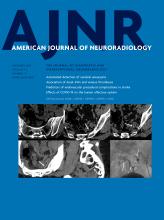Research ArticleHead and Neck Imaging
Open Access
Effects of COVID-19 on the Human Central Olfactory System: A Natural Pre-Post Experiment
E. Thunell, M.G. Peter, V. Lenoir, P. Andersson, B.N. Landis, M. Becker and J.N. Lundström
American Journal of Neuroradiology December 2022, 43 (12) 1777-1783; DOI: https://doi.org/10.3174/ajnr.A7713
E. Thunell
aFrom the Department of Clinical Neuroscience (E.T., M.G.P., J.N.L.), Karolinska Institutet, Stockholm, Sweden
M.G. Peter
aFrom the Department of Clinical Neuroscience (E.T., M.G.P., J.N.L.), Karolinska Institutet, Stockholm, Sweden
V. Lenoir
bDiagnostic Department (V.L., M.B.), Division of Radiology
P. Andersson
dStockholm University Brain Imaging Center (P.A., J.N.L.), Stockholm University, Stockholm, Sweden
B.N. Landis
cDepartment of Otorhinolaryngology (B.N.L.), Rhinology-Olfactology Unit, Geneva University Hospital, Geneva, Switzerland
M. Becker
bDiagnostic Department (V.L., M.B.), Division of Radiology
J.N. Lundström
aFrom the Department of Clinical Neuroscience (E.T., M.G.P., J.N.L.), Karolinska Institutet, Stockholm, Sweden
dStockholm University Brain Imaging Center (P.A., J.N.L.), Stockholm University, Stockholm, Sweden
eMonell Chemical Senses Center (J.N.L.), Philadelphia, Pennsylvania

References
- 1.↵
- 2.↵
- 3.↵
- 4.↵
- 5.↵
- 6.↵
- 7.↵
- 8.↵
- 9.↵
- 10.↵
- Aragão MFVV,
- Leal MC,
- Cartaxo Filho OQ, et al
- 11.↵
- 12.↵
- 13.↵
- Laurendon T,
- Radulesco T,
- Mugnier J, et al
- 14.↵
- Strauss SB,
- Lantos JE,
- Heier LA, et al
- 15.↵
- 16.↵
- 17.↵
- Thunell E,
- Peter MG,
- Lenoir V, et al
- 18.↵
- 19.↵
- Gaser C,
- Dahnke R,
- Kurth K,
- Luders E; Alzheimer’s Disease Neuroimaging Initiative
- 20.↵
- 21.↵
- 22.↵
- 23.↵
- 24.↵
- 25.↵
- Bergmann O,
- Liebl J,
- Bernard S, et al
- 26.↵
- 27.↵
- 28.↵
- 29.↵
- 30.↵
- 31.↵
- 32.↵
- 33.↵
- Wheeler DL,
- Athmer J,
- Meyerholz DK, et al
- 34.↵
In this issue
American Journal of Neuroradiology
Vol. 43, Issue 12
1 Dec 2022
Advertisement
E. Thunell, M.G. Peter, V. Lenoir, P. Andersson, B.N. Landis, M. Becker, J.N. Lundström
Effects of COVID-19 on the Human Central Olfactory System: A Natural Pre-Post Experiment
American Journal of Neuroradiology Dec 2022, 43 (12) 1777-1783; DOI: 10.3174/ajnr.A7713
0 Responses
Jump to section
Related Articles
- No related articles found.
Cited By...
- No citing articles found.
This article has not yet been cited by articles in journals that are participating in Crossref Cited-by Linking.
More in this TOC Section
Similar Articles
Advertisement











